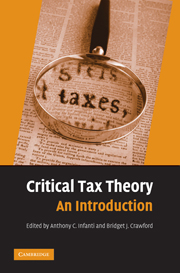Book contents
- Frontmatter
- Contents
- List of Illustrations
- List of Tables
- List of Contributors
- List of Common Abbreviations
- Introduction
- CHAPTER 1 FOUNDATIONS OF CRITICAL TAX THEORY
- CHAPTER 2 HISTORICAL PERSPECTIVES ON TAXATION
- CHAPTER 3 THE GOALS OF TAX POLICY
- CHAPTER 4 CRITICAL TAX THEORY MEETS PRACTICE
- CHAPTER 5 RACE AND TAXATION
- CHAPTER 6 GENDER AND TAXATION
- CHAPTER 7 SEXUAL ORIENTATION AND TAXATION
- CHAPTER 8 THE FAMILY AND TAXATION
- Love, Money, and the IRS: Family, Income-Sharing, and the Joint Income Tax Return
- Innocent Spouses: A Critique of the New Tax Laws Governing Joint and Several Tax Liability
- Taxation and the Family: A Fresh Look at Behavioral Gender Biases in the Code
- The Profits and Penalties of Kinship: Conflicting Meanings of Family in Estate Tax Law
- The Tax Treatment of Children: Separate but Unequal
- Rocking the Tax Code: A Case Study of Employment-Related Child-Care Expenditures
- CHAPTER 9 CLASS AND TAXATION
- CHAPTER 10 DISABILITY AND TAXATION
- CHAPTER 11 GLOBAL CRITICAL PERSPECTIVES ON TAXATION
- CHAPTER 12 CRITICAL PERSPECTIVES ON CRITICAL TAX THEORY
- Index
Taxation and the Family: A Fresh Look at Behavioral Gender Biases in the Code
Published online by Cambridge University Press: 04 August 2010
- Frontmatter
- Contents
- List of Illustrations
- List of Tables
- List of Contributors
- List of Common Abbreviations
- Introduction
- CHAPTER 1 FOUNDATIONS OF CRITICAL TAX THEORY
- CHAPTER 2 HISTORICAL PERSPECTIVES ON TAXATION
- CHAPTER 3 THE GOALS OF TAX POLICY
- CHAPTER 4 CRITICAL TAX THEORY MEETS PRACTICE
- CHAPTER 5 RACE AND TAXATION
- CHAPTER 6 GENDER AND TAXATION
- CHAPTER 7 SEXUAL ORIENTATION AND TAXATION
- CHAPTER 8 THE FAMILY AND TAXATION
- Love, Money, and the IRS: Family, Income-Sharing, and the Joint Income Tax Return
- Innocent Spouses: A Critique of the New Tax Laws Governing Joint and Several Tax Liability
- Taxation and the Family: A Fresh Look at Behavioral Gender Biases in the Code
- The Profits and Penalties of Kinship: Conflicting Meanings of Family in Estate Tax Law
- The Tax Treatment of Children: Separate but Unequal
- Rocking the Tax Code: A Case Study of Employment-Related Child-Care Expenditures
- CHAPTER 9 CLASS AND TAXATION
- CHAPTER 10 DISABILITY AND TAXATION
- CHAPTER 11 GLOBAL CRITICAL PERSPECTIVES ON TAXATION
- CHAPTER 12 CRITICAL PERSPECTIVES ON CRITICAL TAX THEORY
- Index
Summary
Despite increasing levels of participation by women in the workforce, a significant gender gap persists. Married women are working more than ever, but their wages lag far behind those of their husbands. In the newly prototypical two-earner family, each spouse devotes an almost equal amount of time to market work, but the wife typically spends twice as many hours as her husband in home production. Despite the supposed “liberation” of women that has transpired over the last several decades, our social models of the family and workplace remain largely unchanged. For example, part-time labor, which would seem an attractive option in a reconceived work–family dynamic, predominantly remains lower paying, less prestigious, and less desirable than full-time labor. More generally, the “new” two-earner family seems largely to have added extra workplace responsibilities to the wife's burdens, while holding most of the husband's activities and the wife's nonmarket production constant. And, while fewer than 10% of all Americans still live in a version of the “traditional” family of some time ago – the working husband and the stay-at-home wife – society has struggled to develop alternative visions of the family.
Tax laws play a role in all of this. A reformulated tax policy could be more sensitive to the character and aspirations of mundane existence; tax laws are well suited to a system of individualized incentives. Yet traditional tax policy often seems stuck in a rut of static, distributive thinking, typically asking who “wins” and who “loses” – that is, who presently pays more dollars out-of-pocket to the fisc – from a putative tax reform. With respect to families, this focus has produced a battle of the “neutralities.”
- Type
- Chapter
- Information
- Critical Tax TheoryAn Introduction, pp. 239 - 245Publisher: Cambridge University PressPrint publication year: 2009
- 2
- Cited by



